Play with our Prototypes
Spore has been a huge undertaking. Along the way we ended up exploring countless design directions in gameplay, simulation and user interface.
One of the ways in which we explore possible design directions is by building simple, playable prototypes that we can play around with to get a sense for a particular system.
Usually these prototypes are never seen by the public, but we thought some of the more intrepid players out there might enjoy playing around with a few of our early spore prototypes. Keep in mind these are not tested, supported or even easily explained.
. Mac OS X Gift Pack
The Mac OS X Gift Pack includes a small suite of tools that were written to experiment with some of the spore.com feeds. On the disk image, you will find: a Dashboard widget that shows the current set of Featured Creations, a Dashboard widget that lets you see any spore.com user’s latest creations, and a screen saver that shows images from a feed. The README on the disk image will give you more information about installation. 

) Tidepool 
Tide Pool represents our first steps down the path toward synthesizing our ideas into a playable game.
Tide Pool set the stage for the later, more recognizably Spore-like prototypes SPUG and GonzagoGL.
Tide Pool combines a forest fire simulator from BIOME with the terrain and water simulation from WaterBoy and the flocking system from Crowd in a fire fighting mini game.

 GonzagoGL
GonzagoGL
GonzagoGL is an OpenGL-based prototype of the Spore Creature game.
Similar to SPUG, it places the player in an environment with predators, prey, shelter and vegetation. GonzagoGL advances the SPUG model to include higher quality terrain and a greater emphasis on gameplay.
GonzagoGL was the final gameplay prototype developed for Spore.
 Waterboy
Waterboy 
WaterBoy is a fluid dynamics simulator designed to explore the behavior of large bodies of water on uneven terrain.
Developed in 2002, WaterBoy also demonstrates early application of modern graphics technology, including environment cube mapping and custom shaders.
 NetCity
NetCity 
NetCity is a programmable simulator used to explore the evolution of complex behavior from simple components.
User-defined nodes can be set to emit signals and move, or shrink and grow in when a signal is received.
NetCity was inspired by the Soda Constructor ( sodaplay.com ) and by the book Vehicles: Experiments in Synthetic Psychology by Valentino Braitenberg.
 Gaslight
Gaslight 
Gaslight simulates a process called stochastic, self-propagating star formation (SSPSF.)
Interstellar gas and dust begin to collapse under the force of its own gravity. This gives rise to regions of dense material that eventually give rise to stars.
When the stars ignite, they heat up the surrounding material, which moves away from the stars, creating more regions of increased density, which give rise to more stars, which moves more material, which creates more stars and so on.
Crowd 
Crowd is a SimCity 4 prototype developed by the Spore prototyping team.
The player controls a neighborhood of city blocks. Sims wander the city looking for residential, commercial or industrial buildings where they can work, rest or recreate.
The player may zone the unzoned (gray) city blocks to attract sims of a given type. Zoned buildings also emit traffic vehicles, which can be controlled with traffic lights.
SPUG 
SPUG is a tunable gameplay prototype for the Creature level of Spore.
The player controls an avatar creature on a simple planetary terrain where they may hunt prey, evade predators, eat, rest and level up their stats.
No limitations are placed on leveling up or cheating stats. This tool was intended to give designers the opportunity to explore different economies for the creature game, so limitations on power ups and level ups are self-imposed.

Cell Culture 
Cell Culture is a SimCity-like simulation of the spread of life and culture across a planetary surface.
The planet is represented as a grid of cells. Each cell has several variables describing the amount and kind of life present at that location.
Life grows and spreads from cell to cell based on these variables. The more favorable the conditions, the faster the rate of growth and spread.
Spore has been a huge undertaking. Along the way we ended up exploring countless design directions in gameplay, simulation and user interface.
One of the ways in which we explore possible design directions is by building simple, playable prototypes that we can play around with to get a sense for a particular system.
Usually these prototypes are never seen by the public, but we thought some of the more intrepid players out there might enjoy playing around with a few of our early spore prototypes. Keep in mind these are not tested, supported or even easily explained.
The Mac OS X Gift Pack includes a small suite of tools that were written to experiment with some of the spore.com feeds. On the disk image, you will find: a Dashboard widget that shows the current set of Featured Creations, a Dashboard widget that lets you see any spore.com user’s latest creations, and a screen saver that shows images from a feed. The README on the disk image will give you more information about installation. 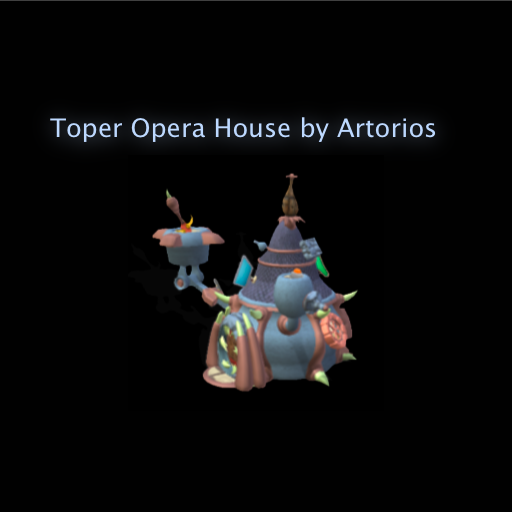
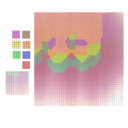

Tide Pool represents our first steps down the path toward synthesizing our ideas into a playable game.
Tide Pool set the stage for the later, more recognizably Spore-like prototypes SPUG and GonzagoGL.
Tide Pool combines a forest fire simulator from BIOME with the terrain and water simulation from WaterBoy and the flocking system from Crowd in a fire fighting mini game.
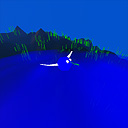
 GonzagoGL
GonzagoGL
GonzagoGL is an OpenGL-based prototype of the Spore Creature game.
Similar to SPUG, it places the player in an environment with predators, prey, shelter and vegetation. GonzagoGL advances the SPUG model to include higher quality terrain and a greater emphasis on gameplay.
GonzagoGL was the final gameplay prototype developed for Spore.
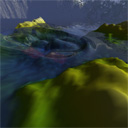 Waterboy
Waterboy 
WaterBoy is a fluid dynamics simulator designed to explore the behavior of large bodies of water on uneven terrain.
Developed in 2002, WaterBoy also demonstrates early application of modern graphics technology, including environment cube mapping and custom shaders.
 NetCity
NetCity 
NetCity is a programmable simulator used to explore the evolution of complex behavior from simple components.
User-defined nodes can be set to emit signals and move, or shrink and grow in when a signal is received.
NetCity was inspired by the Soda Constructor ( sodaplay.com ) and by the book Vehicles: Experiments in Synthetic Psychology by Valentino Braitenberg.
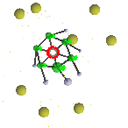 Gaslight
Gaslight 
Gaslight simulates a process called stochastic, self-propagating star formation (SSPSF.)
Interstellar gas and dust begin to collapse under the force of its own gravity. This gives rise to regions of dense material that eventually give rise to stars.
When the stars ignite, they heat up the surrounding material, which moves away from the stars, creating more regions of increased density, which give rise to more stars, which moves more material, which creates more stars and so on.
Crowd 
Crowd is a SimCity 4 prototype developed by the Spore prototyping team.
The player controls a neighborhood of city blocks. Sims wander the city looking for residential, commercial or industrial buildings where they can work, rest or recreate.
The player may zone the unzoned (gray) city blocks to attract sims of a given type. Zoned buildings also emit traffic vehicles, which can be controlled with traffic lights.
Crowd is a SimCity 4 prototype developed by the Spore prototyping team.
The player controls a neighborhood of city blocks. Sims wander the city looking for residential, commercial or industrial buildings where they can work, rest or recreate.
The player may zone the unzoned (gray) city blocks to attract sims of a given type. Zoned buildings also emit traffic vehicles, which can be controlled with traffic lights.

SPUG is a tunable gameplay prototype for the Creature level of Spore.
The player controls an avatar creature on a simple planetary terrain where they may hunt prey, evade predators, eat, rest and level up their stats.
No limitations are placed on leveling up or cheating stats. This tool was intended to give designers the opportunity to explore different economies for the creature game, so limitations on power ups and level ups are self-imposed.

Cell Culture 
Cell Culture is a SimCity-like simulation of the spread of life and culture across a planetary surface.
The planet is represented as a grid of cells. Each cell has several variables describing the amount and kind of life present at that location.
Life grows and spreads from cell to cell based on these variables. The more favorable the conditions, the faster the rate of growth and spread.
Cell Culture is a SimCity-like simulation of the spread of life and culture across a planetary surface.
The planet is represented as a grid of cells. Each cell has several variables describing the amount and kind of life present at that location.
Life grows and spreads from cell to cell based on these variables. The more favorable the conditions, the faster the rate of growth and spread.
City Maze 
City Maze is an agent-based city simulation prototype. The player controls a city of sim creatures.
Players may place residential, industrial, entertainment and defense buildings. When sims enter these buildings, they rest, produce income, improve their mood or defend against raider attacks.
Happy, safe, rested sims will multiply and produce income. Miserable, threatened, tired sims will get fed up and leave the city.
City Maze is an agent-based city simulation prototype. The player controls a city of sim creatures.
Players may place residential, industrial, entertainment and defense buildings. When sims enter these buildings, they rest, produce income, improve their mood or defend against raider attacks.
Happy, safe, rested sims will multiply and produce income. Miserable, threatened, tired sims will get fed up and leave the city.
 BIOME
BIOME 
BIOME is a programmable cellular automata simulator that allows users to develop simple “SimCity-like” grid simulations.
The grid-simulations in SimCity were inspired by Conway’s “Life” program, which produces amazingly intricate patterns from simple rules
BIOME uses a language based on chemical stoichiometry, the notation system used to describe chemical reactions. Cells in a BIOME simulation change state the same way that chemicals change when exposed to other chemicals
Systems such as this can be used to simulate phenomena such as forest fires, disease epidemics, animal migration patterns and crystallization
BIOME supports both rectangular and spiral cellular automata configurations. The spiral configuration was used to study stochastic, self-propagating star formation (the process whereby the ignition of a star promotes the creation of more stars) on the galactic scale.
ParticleMan
ParticleMan simulates gravitational attraction between particles in a cloud. This system was used to study such gravitational dynamics as orbits, nebula formation, star formation and particle streams from sources like pulsars and black holes.
ParticleMan has the following elements:

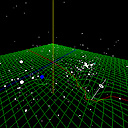 Particles – point masses which interact with each other Gravity Wells – Fixed point masses which attract or repel particles (depending on magnitude, which can be negative), but do not move or change mass without user input Particle Guns – sources that spit particles out at a given angle and velocity
Particles – point masses which interact with each other Gravity Wells – Fixed point masses which attract or repel particles (depending on magnitude, which can be negative), but do not move or change mass without user input Particle Guns – sources that spit particles out at a given angle and velocity
- Gravity Wells and Particle Guns may only be placed on the green grid in the z=0 plane.
- The Iso Surface – an isosurface geometry object derived from the positions and masses (which act as field strengths) of the particles.
Turn ‘particle-particle interactions’ under physics off and on to see the difference between the more orderly and predictable independent particles and the chaotic interacting ones.
With particle-particle interactions off, you can create some elaborate streams of particles using the Particle Gun and Gravity Well objects.
Play with physics controls to create different kinds of gravitational simulations. High fusion rates can be used to simulate star birth in collapsing nebulae, for example and low fusion rates can be used to simulate interaction between stars in a galaxy.
Read More





GIPHY App Key not set. Please check settings